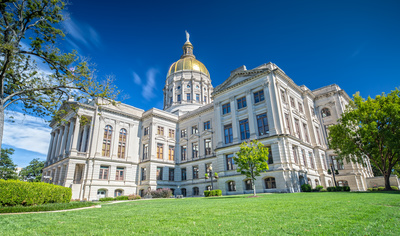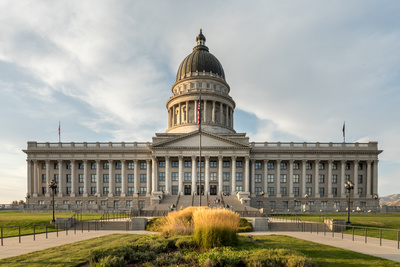
Elections & Campaigns, Energy & Environment
Nine States Face Key Public Utility Commission Elections Ahead of 2026
October 27, 2025 | Billy Culleton
February 14, 2018 | Ryan Maness
Washington Governor Jay Inslee (D) made headlines earlier this year when he announced that passing a carbon tax would be one of his key policy goals for the year. Left-leaning
Including the marquee proposals in Washington, 10 states have introduced 30 bills that seek to use fiscal policy tools to curb environmental pollution. The general theory behind these bills is that the price of carbon-intensive pollutants does not fully reflect their societal cost, so the state should levy a tax to recoup the difference. A similar theory undergirds taxes on soda and tobacco products, where proponents argue that the prices of sugar and nicotine do not reflect the full costs of their human consequences, such as diabetes and lung cancer.
Unlike cigarette or soda taxes, however, carbon taxes are still a novel policy, so lawmakers have not yet worked out the best practices for how they should be structured. Bill sponsors are still feeling out precisely what should be taxed, what the tax rate should be, and how to allocate the new revenue.
To provide a basic analysis of the current legislative state of play, we'll consider each of these questions.

The tax base for most of these direct tax bills is typically defined as the carbon content released when fossil fuels are first used, expended, or sold in the state. The bills further instruct state officials to rely on a number of scientific and expert sources to establish a schedule of the precise carbon calculations for the fuels within the state, including the state environmental agencies and U.S. Environmental Protection Agency. Given how controversies surrounding environmental science, establishing a common legal consensus on this issue could create
The differences between the states' legislation arise in what exemptions and exclusions they allow. For example, while most bills seek to explicitly extend the tax to fuels expended to generate electricity, the Massachusetts bill (MA SB 1821) and one Vermont bill (VT SB 284) provide broad electrical exemptions. Four Washington bills provide for exemptions for electricity sold to different lists of “energy intensive trade-exposed industries,” including chicken egg production, frozen produce manufacturing,
Many of the bills also include exemptions for fuels transported into the state in a fuel tank, fuels otherwise prohibited from taxation under state or federal law, and electricity exported out of the state.
Although these carbon taxes are trying to bring the price of carbon in line with its societal cost, there still isn't a consensus on the actual dollar-value of that cost. As a result, these bills employ a relatively wide range of tax rates. At the low-end, all of the Vermont bills set a rate of $5 per ton of carbon. At the high-end, a pair of New York bills (NY AB 107/SB 2846) establish a rate of no less than $35 per ton.
Beyond this base cost, all of the bills increase the value of the tax over time to encourage the development of non-carbon-intensive fuel sources, but again, these increases vary. For example, one Washington bill (WA SB 6335) sets a base rate of $15 dollars that increases only once to $20 after five years. The Maryland bill also includes novel provisions to allow the state to increase the price to keep up with pollution life cycle issues and state progress toward taking emission targets. All of the rest of the bills increase the tax rate every year (typically by $5 per year) to some established cap, which
One New York bill (NY SB 7645) utilizes an entirely novel rate structure that is worth singling out. It establishes a commission to conduct a study to establish an index of the exact “social cost” of a variety of pollutants and to levy fees to reflect this index.
Instead of raising revenues for their states' general funds, most of these proposals earmark their revenue for a variety of specific — mostly environmental — programs. The Rhode Island bills would charter a new “Energize Rhode Island Fund” that would help transition workers into low-carbon industries, expand renewable energy access to small businesses, and incentivize investment in and development of clean forms of energy. Similarly, several of the Washington bills share a set ecologically-related goals, including reducing transportation-related pollution, developing environmentally friendly infrastructure, sequestering carbon, mitigating forest fires, and controlling storm water.
Other bills attempt to use their new revenue to alleviate the burden the tax imposes on energy consumers. For example, WA S.B. 5930 aims to benefit the state's neediest populations by distributing some of its funds to programs like tax assistance for needy families and cash assistance programs for individuals with disabilities. One Massachusetts bill sets up a rebate program to return the proceeds back to consumers at a rate roughly equivalent to what they paid on their energy bill.
New Hampshire, New Mexico, New York, and Vermont have all introduced similar legislation to form committees to study whether carbon taxes would be feasible their states. While studying an issue is by no means a guarantee of an eventual bill introduction, the proliferation of these bills beyond the coasts is an indication of a growing interest in this policy.
Although direct carbon taxes are states' most expansive approach to combating climate change, they are not the only policy that they are exploring. Oregon has a set of bills (OR HB 4001/SB 1507) that would establish a cap on total greenhouse gas
Carbon taxes are still mostly the province of Democratic legislatures, but if this fall's mid-term elections sweep more Democrats into office, we can expect the idea to continue to spread across the country.

October 27, 2025 | Billy Culleton
-000055-400px.jpeg)
October 8, 2025 | Abbie Telgenhof, Morgan Scarboro

August 13, 2025 | Bill Kramer